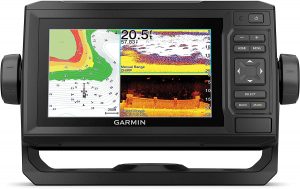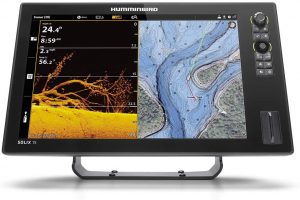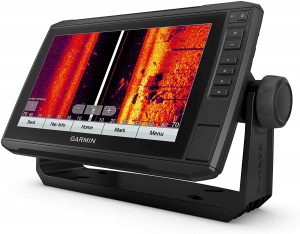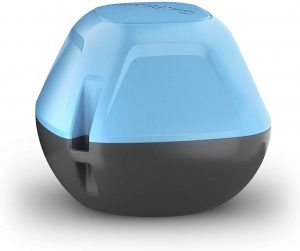There are plenty of fish in the sea (or lake) – and plenty of fish finders to find them with. With so many choices, it can be hard for an angler to figure out which fish finder is right for them. If you’re trying to work out which fish finder will suit your needs best, you’re in the right place.
Quick Navigation:
How To Choose A Fish Finder | Best Fish Finders
How To Choose A Fish Finder
When choosing a fish finder, you need to ask yourself some key questions to determine the top option for you.
What Kind Of Fishing Do You Do?
We don’t mean “what kind of fish do you want to catch” – fish finders will find any kind of fish, big and small, as well as non-fish objects in the water.
What we mean is this: you should ask yourself where and how you fish. If you love ice fishing, you’re going to need a very different device than the folks who don’t need to use an auger before they cast a line.
In the same (not so icy) vein, if you only ever fish in shallow water, a 200 kHz that can find fish 600’ deep isn’t going to be much of a bonus. Fish finders can have a lot of bells and whistles, and while some anglers need them all, most don’t. A fish finder for deep ocean water fishing will have more power than something designed for freshwater and shallower depths. Keep this in mind when looking for a device.
Do You Fish Competitively?
When you fish competitively – or even if you just take fishing pretty seriously – you’re going to want a whole different set of tools than someone who fishes casually.
Tournament anglers, for example, tend to get a lot more use out of fish finder/chartplotter combos. They can use the chartplotter to pre-fish the lake before a tournament, creating comprehensive routes to all their favorite fishing spots.
Some fish finders also come with advanced features like imaging technology. The more seriously you take fishing, the more valuable these extras will be to you.
What Other Devices Do You Have On Your Boat?
If you’ve already got a GPS on your phone, you might find a fish finder/chartplotter combo less useful – especially if you’re not taking advantage of the routes and waypoints on the latter.
Or, you might want to choose fish finders that are cross-compatible with the other transducers and map packs you already own. You’ll also want to choose a fish finder that can easily connect with your other devices – NMEA2000 compatibility and other networking features are important considerations.
This means you’ll often end up sticking with the same manufacturer for any given setup – this more or less ensures some degree of cross-compatibility and connectivity between your fish finders.
How Much Space Do You Have?
In the world of fish finders, bigger generally is better. Larger units have more space for hardware, which can mean more storage and better processors. It also means a larger screen – and bigger screens are easier to navigate and read.
Of course, not every boat has room for a huge fish finder. If you’re using a kayak, good luck mounting a 15” fish finder on the thing. And if you’ve already got devices all over your boat, you might need to look for a smaller finder.
Personal preference
With all of those considerations in mind, there are some things that come down to personal preference.
Some anglers absolutely love imaging – others want to stick with the old sonar graphs. Some anglers won’t fish without the old school flasher.
You might have a color palette that suits you particularly well. You might hate touchscreens. Keep these preferences in mind when shopping for a fish finder.
Our favorite fish finders
With all that, let’s look at some of the best fish finders on the market for anglers of all stripes.
Best fish finders: the Humminbird SOLIX Series
The SOLIX series by Humminbird is our pick for the best fish finder on the market right now. Why? Because:
- Navigation is ridiculously simple, with both a touchscreen and a joystick
- The cross-compatibility and networking of the unit is incredible
- The transducer that comes with it has a stunning array of depths and ranges
- The Down and Side Imaging features are spectacular
- It’s fast
- It’s compatible with some of the best maps in the industry
While these are the best fish finders, the price is quite steep. Only purchase it if you know you’re going to use all of the features – you’ll be glad you did. If this is out of your price range, you should consider some of the affordable, but still high quality alternatives below.
You can find different size screens available as well.
View 15 inch on Amazon | View 10 Inch On Amazon
Best Midrange fish Finder/Chartplotter: The Garmin Echomap UHD 93sv
For around $1000, you can get the Garmin Echomap UHD 93sv. We love this unit because it comes with:
- A great display
- Incredible Side/Down Imaging
- Wi-Fi and NMEA compatibility
- ActiveCaptain app compatibility
- Great mapping features
While it may not be as fast as the SOLIX series, and the out-of-the-box transducer has fewer frequencies, this is an excellent device for enthusiasts who want to upgrade their imaging technology without breaking the bank.
View On Amazon | View On Garmin
Best Budget Fish Finder/Chartplotter: Garmin Echomap UHD 63cv
 Two Echomaps in our best of – Garmin must be doing something right. You can get the UHD 63cv for well under $1000, making it one of the least expensive fish finder/chartplotter combos you can find. Despite its low price, you get:
Two Echomaps in our best of – Garmin must be doing something right. You can get the UHD 63cv for well under $1000, making it one of the least expensive fish finder/chartplotter combos you can find. Despite its low price, you get:
- A great display
- Down Imaging
- Wi-Fi and NMEA2000 compatibility
- ActiveCaptain app compatibility
- Great mapping features
The only real knocks against this unit? It’s a bit small (which makes it a good choice for smaller setups), it doesn’t have a touchscreen, and it doesn’t have Side Imaging.
View On Amazon | View On Garmin
Best Device For Small Setups: Garmin STRIKER Cast
3 out of our top 5 go to Garmin – other manufacturers should take notes. The STRIKER Cast almost didn’t make the list because it’s not quite a fish finder – it’s a transducer/GPS combo that connects to your phone.
That means it’s incredibly small, and very affordable. While its sonar maxes out at 150 feet, making it a less than stellar choice for deepwater anglers, it’s great for those who want to fish in a kayak or other small boats.
Best Fish Finder For Ice Fishing: Vexilar FLX 30
When it comes to ice fishing fish finders, bells and whistles can be a liability. You want a unit that can endure cold temperatures, with an iceducer that’s built for being submerged in near freezing temperatures. You don’t need imaging, a GPS, or a touchscreen – just a rugged flasher that’s built to last.
The FLX 30 is easy to read, has plenty of options for frequencies and interference rejection, and has a long-lasting battery. You can use it day and night. It’s exactly what you need for ice fishing.
We hope this piece has helped you find the fish finder that’s right for you. If you have any questions or comments, contact us! We’d love to talk to you.
Max DesMarais is the founder of hikingandfishing.com. He has a passion for the outdoors and making outdoor education and adventure more accessible. Max is a published author for various outdoor adventure, travel, and marketing websites. He is an experienced hiker, backpacker, fly fisherman, trail runner, and spends his free time in the outdoors. These adventures allow him to test gear, learn new skills, and experience new places so that he can educate others. Max grew up hiking all around New Hampshire and New England. He became obsessed with the New Hampshire mountains, and the NH 48, where he guided hikes and trail runs in the White Mountains. Since moving out west, Max has continued his frequent adventures in the mountains, always testing gear, learning skills, gaining experience, and building his endurance for outdoor sports. You can read more about his experience here: hikingandfishing/about
-
Beauty
-
Parking
-
Trail Conditions




